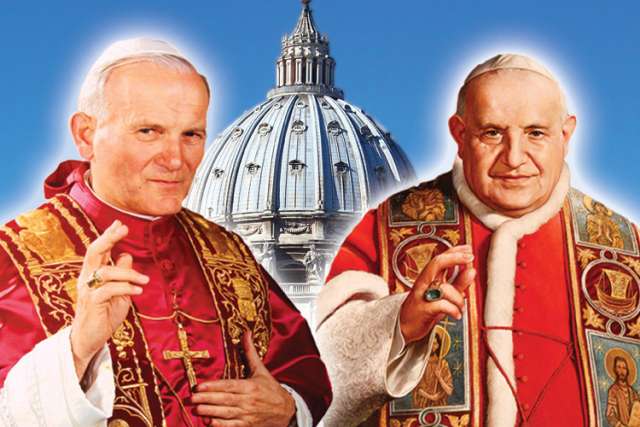That adage can be readily applied to the Church’s two new saints. Pope John XXIII and Pope John Paul II were contrasts in nationality, upbringing, personality and approaches to the papacy. But they mirrored each other in one central way: they both led extraordinary lives of virtue founded on physical and moral courage. Long before Pope Francis united them in sainthood, the two former popes were linked by the heroic ways they conducted their lives and their papacies.
John XXIII is best remembered, of course, for convoking the Second Vatican Council. It was a brave act. He was 77 and regarded as a transitional pope following the long papacy of Pius XXII. A holy, humble, humourous man by nature, Pope John was personally popular but not regarded in 1959 as someone likely to reshape the Church in a world teetering on technical and social upheaval.
But he not only convened Vatican II to review many centuries-old practices of the Church, but he invited non-Catholics to join his bishops in a discussion on Christian unity. Vatican II was a monumental initiative that no one saw coming. Pope John knew there would be opposition — and perhaps some ridicule for someone his age being so bold — but he had the courage to follow the guiding hand of the Holy Spirit.
It might have been the same call he heard as a teenager when he displeased his parents and bravely left the only life he knew in a farming village to join the seminary. Or the same call that motivated him to spirit countless Jews away from Nazi death camps during World War II.
Similarly, John Paul II demonstrated that a virtuous life is a courageous one.
His disdain for communism and his championing of human freedom and dignity represented a fearless defence of Church teaching. As a young man, he defied the Nazis to enter a secret seminary. As pope, he survived an assassin’s bullet, confidently crossed barriers by visiting synagogues and mosques and had the certainty to make unprecedented apologies for historical Church wrongs committed during the Inquisition and Crusades. He never shied from standing firmly against abortion and euthanasia, nor locking arms with the defenders of traditional family life.
John Paul’s first public utterance as pope was, “Do not be afraid.” He lived those words many years later when, afflicted by Parkinson’s disease, he gave the world a courageous witness to suffering and death.
“To have courage for whatever comes in life — everything lies in that,” said St. Teresa of Avila. The lives of the two new saints of the Church bear witness to that truth.


